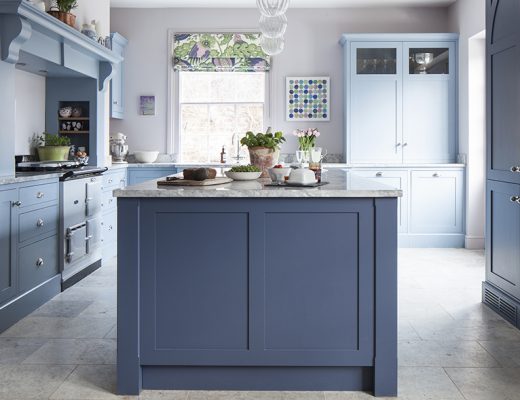Looking to buy a new fridge? Choosing the right model and putting it in the right place is key to a successful kitchen. So, we’ve asked the experts to weigh in on which to install in your space…
When buying a new fridge, consider which type suits your kitchen layout best. Do you want a cooling appliance that is discreetly hidden, built-in behind cabinet doors, or a freestanding model on show?
“Freestanding double-door US or French-door fridge-freezers with a freezer drawer beneath suit larger or open-plan kitchens where there is enough clearance around the appliance,” Tim Higham, founder of Higham Furniture, tells KBB journo Sally Smith. “So that you can walk around it when the doors are open.”

In smaller kitchens, refrigeration drawers with flexible chilled-to-freeze settings are a good option. Tom Howley, creative design director at Tom Howley, adds that “built-under metre-wide fridge drawers work well in galley kitchens, allowing for efficient storage without compromising on space”.

For L-shaped kitchens, consider a tall fridge placed at the end of the longer wall so as not to disrupt the flow. In any case, ensure your fridge can easily be accessed from the preparation area.
Choose the right fridge size
The capacity of your refrigeration appliance and what proportion of chilled and frozen storage you need is one of the first things to consider and discuss with your kitchen designer – a 70/30 ratio, for example, would be best if you prefer to stock up on fresh produce.

Nestor Garcia, senior design consultant at Kutchenhaus says, “Getting this right is key. The width of the fridge area is important, and will determine whether the model should be freestanding or built-in. Bear in mind, if you choose a separate fridge and freezer, this will restrict design options in the layout due to the space needed for two separate appliances.”

Freestanding appliances are bigger both inside and out, with some up to 90cm wide. This obviously results in them taking up more space in the layout than the smaller built-in models which are made to fit within standard kitchen cabinets.
When buying a new fridge, keep in mind that capacities vary. The larger French-door freestanding fridge-freezers have around 600 litres of storage space as opposed to a tall built-in fridge with a capacity of approximately 276 litres, but you can double up with a side-by-side combo.
A handy undercounter drinks fridge is smaller, fitting around 135 litres, but is perfect for storing your cocktail collection or favourite wine.


Buying tips and functionality
When buying a new fridge, look out for the latest AI tech appliances that offer ‘knock to open’ doors which work well in a handleless kitchen design.
If you choose a refrigeration model that includes an ice and water dispenser, it may need to be plumbed into the main water supply. This will have to be taken into account in the layout. So, check the appliance will be the best fit with your kitchen designer before you buy.

For something more advanced, thanks to Wifi connectivity, smart refrigerators are often compatible with voice assistants like Alexa, they remotely monitor the temperature of your appliance, tell you if the door has been left ajar, or what’s left in the fridge – and even suggest recipes based on the available produce.
What will it cost?
A high-end freestanding refrigeration appliance will cost around £2000 with the top-of-the-range luxury models costing £10,000-plus. Undercounter built-in models, ideal as a second fridge in an island or drinks station, are priced £800 or more. Taller units come in over £1500 depending on the brand.
However, you will need to factor in the cost of installing the cabinetry on the door of a built-in appliance. A pair of the latest flexible chilled-to-frozen integrated drawers is priced between £3000 and £5000.


Good to know
Don’t forget to check the specification details of the appliance when buying a new fridge. And, when it comes to positioning, Al Bruce, founder of Olive & Barr, advises to “think about door clearance and air flow, as all models require enough space behind and above to allow for adequate ventilation”.

If you’re planning to put a freestanding appliance next to a wall or kitchen unit, you’ll need to leave a gap of around 17.5cm on the hinged side of the appliance to allow the door to open.
Built-in models will also require air ow vents that will need to be designed and integrated into the kitchen cabinetry.





